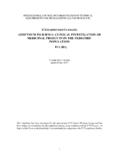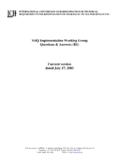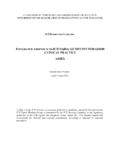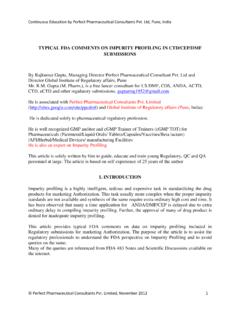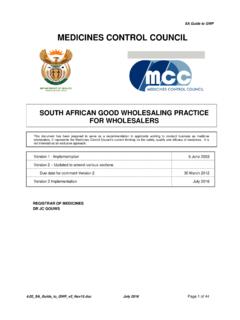Transcription of Final Business Plan Q3D: Impurities: Guideline for ...
1 Final Business Plan Q3D: impurities : Guideline for Elemental impurities Dated 17 July 2009. Endorsed by the Steering Committee on 29 October 2009. The Issue and its Costs There is currently no harmonised guidance to assure appropriate control of metal impurities in drug products and ingredients. The ICH Q3A Guideline classifies impurities as organic, inorganic, and residual solvents. Whereas organic impurities and residual solvents are appropriately addressed in ICH Guidelines, inorganic impurities are not. Only the following information regarding inorganic impurities is provided in the ICH Q3A Guideline : "Inorganic impurities are normally detected and quantified using pharmacopoeial or other appropriate procedures.
2 Carry-over of catalysts to the new drug substance should be evaluated during development. The need for inclusion or exclusion of inorganic impurities in the new drug substance specification should be discussed. Acceptance criteria should be based on pharmacopoeial standards or known safety data.". There are significant issues that arise from this limited guidance as listed below: The current pharmacopoeial procedures to control inorganic impurities include the Heavy Metals test, Residue on Ignition/Sulphated Ash, and other wet-chemistry tests. While these tests for inorganic impurities may be suitable in certain cases, the procedures also have some deficiencies: they may be non-specific and were not developed to detect low-level residual metal catalysts and reagents which may be used in modern synthetic processes.
3 The Heavy Metals test in particular is often used for broad screening of potential metal impurities , without appropriate consideration of a risk-based approach to control metals that are likely to be present. The acceptance criteria provided in pharmacopoeial standards are based on historical precedent and not necessarily on appropriate safety data. The number of metals which are actually detected by the usual pharmacopoeial procedures, especially the Heavy Metals test, is limited and does not include many of the metals which have the greatest toxicological concern. The current reliance on pharmacopoeial standards to control inorganic impurities presents other significant issues.
4 The analytical procedures and acceptance criteria in the pharmacopoeias may be provided in general chapters and specific monographs for excipients, drug substances, and drug products. While general chapters and excipient monographs are currently in the scope of PDG harmonisation, drug substance and product monographs are not. Some of the general chapters for inorganic impurities are included in the PDG work programme for harmonisation, but others are not. Even for general chapters that are being considered by PDG for harmonisation, the fundamental approaches taken by the various pharmacopoeias are not always consistent, making the likelihood of a harmonised outcome unlikely.
5 The overall result is inconsistency in the general analytical procedures and specific International Conference on Harmonisation of Technical Requirements for Registration of Pharmaceuticals for Human Use ICH Secretariat, Chemin Louis-Dunant 15, Box 195, 1211 Geneva 20, Switzerland Telephone: +41 (22) 338 32 06, Telefax: +41 (22) 338 32 30. Final Q3D EWG Business Plan Endorsed: 29 October 2009 acceptance criteria for controlling metal impurities in drug products and ingredients, with insufficient control for those metals with the highest associated safety risk to patients. The challenges associated with non-harmonised pharmacopoeial standards for inorganic impurities are exacerbated when consideration is given to the lack of harmonised regulatory guidance in this area.
6 While guidance on specification limits for residues of metal catalysts and reagents was recently provided by EMA, similar regulatory guidance has not yet been provided from the US or Japan for public review. Additionally, due to its scope, the EMA. guidance does not address several metals posing significant toxicological concerns, in particular lead, mercury, arsenic, and cadmium. Finally, upon review of recently published proposals from USP for possible revision to their Heavy Metals test, the possible divergence in approach and acceptance criteria among the three major pharmacopoeias and from the EMA regulatory guidance emerged as a possible outcome.
7 While the current lack of clear and consistent guidance for the control of inorganic impurities is very problematic for the pharmaceutical industry, the primary concern is ensuring the safety of the patient. A harmonised ICH Guideline to address inorganic impurities , and specifically metal impurities , will help ensure appropriate control for these impurities , to the benefit of public health. The ICH Guideline will ensure that new requirements have the necessary input of the regional regulatory authorities to help protect patient safety, and should also help to avoid differing approaches and standards among the pharmacopoeias and the regulators.
8 This consistency will avoid current redundant testing to meet different requirements, and will make the implementation of the harmonised outcomes more readily achievable by the pharmaceutical industry. Financial Costs Focusing on the Heavy Metals test, the costs associated with the lack of pharmacopoeial harmonisation may be summarised as follows: performing each individual test requires about 3-4 personnel-hours (estimate for a pharmaceutical manufacturer laboratory) or around $200- $600 (cost for contract laboratory testing), depending on the particular procedure and sample. Having to perform 3 different methods instead of 1 harmonised method thus results in additional costs of 6-8 hours or $400-$1200 per sample.
9 This cost is greatly magnified when considering the significant number of compendial monographs which contain the test requirement for Heavy Metals (around 700-900 individual monographs in each of the USP, Ph. Eur., and JP), as well as the large number of lots of API and excipient which are manufactured or received and tested for use by pharmaceutical companies. Additional cost considerations would result from the recent USP proposal to replace the wet chemical Heavy Metals test with an instrumental procedure (AA, ICP-OES, or ICPMS) for use in broad screening for metal contamination. These instruments may cost from around $60,000 for AA to $100,000 for ICP-OES and up to $200,000 for ICP-MS.
10 Further costs associated with these instruments include maintenance (service contracts are estimated to cost around 10% of the instrument purchase price per year), analyst training, materials, chemicals ( , argon gas for ICP) and reference standards. Planning The expected deliverables are as follows: Harmonised, safety-based limits for metal impurities , especially those with highest toxicological concerns. 2. Final Q3D EWG Business Plan Endorsed: 29 October 2009 Appropriate risk-based approach to ensure control for metals likely to be present in drug products and ingredients, including those resulting from the manufacturing process (metal catalysts and reagents), as well as those due to the material source ( , Pb, Hg, As, Cd).
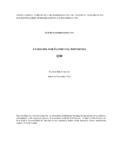
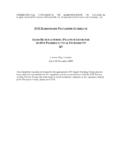
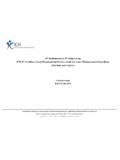
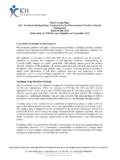
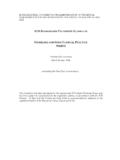
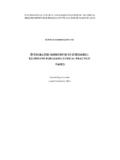
![[ICH E2F] [EXAMPLE DSUR – PHASE III …](/cache/preview/1/3/5/f/e/1/c/f/thumb-135fe1cf2cdb82799c462ad0ea089c48.jpg)
